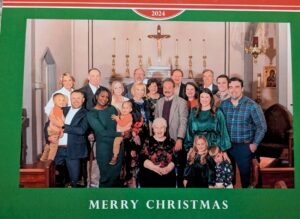The holidays are a time of joy, nostalgia, and—let’s be honest—a bit of low-level chaos. For many, they’re a chance to reconnect with deeply ingrained traditions that often go unnoticed, like the unconscious rhythm of a favorite holiday song. Yet, traditions can be a source of cognitive dissonance for some, especially those merging families. After all, when two very different holiday worlds collide, it’s less “Silent Night” and more “Clash of the Carols.”
The interplay of family traditions has enriched my life and, at times, bewildered me. I want to explore the curious power of these rituals. Along the way, I’ll share a deeply personal story about my first Christmas with my wife and how it taught me that blending traditions requires equal parts patience, humor, and an ability to laugh at the absurdity of it all.
Traditions: The Glue of the Holidays
Holiday traditions are more than just a series of actions repeated year after year. They are the glue that binds generations together, providing a sense of continuity and comfort. They remind us of where we come from, who we are, and—when we encounter a new set of traditions—just how bizarre our own family might seem to someone else.
These rituals are often so ingrained that we mistake them for universal truths. For instance, if you grew up baking cookies with your grandmother every December 23rd, you might assume that everyone considers flour-dusted countertops essential to the holiday spirit. But then you marry into a family where the pre-Christmas ritual involves competitive gingerbread house construction—and suddenly, your sugar cookie cutters feel a bit underwhelming.
My First Christmas with My Wife: A Tale of Two Holiday Worlds
When I married my wife, I thought I knew what to expect from Christmas. I grew up in a family of eight children, where the holiday was a meticulously choreographed giving marathon. Gifts were opened individually, with each person taking center stage as their gift was unveiled in multiple sessions. This process stretched over an entire day, with breaks for breakfast, coffee, and lunch, and countless anecdotes about how “Santa knew exactly what I needed.”
This slow and deliberate approach wasn’t just a tradition but a lifestyle. We valued suspense, savoring each
My wife, however, grew up in a family of 10 children, where Christmas was a very different kind of celebration. In her family, there were no wrapped gifts. Instead, every child had a designated chair, which functioned as a personal Christmas loot pile. On Christmas morning, everyone would rush to their chair and begin sifting through the bounty. The spectacle was more “Black Friday doorbuster” than “quiet holiday reflection.”
The first time we spent Christmas together, the dissonance between our traditions was staggering. I was baffled by the unwrapped gifts and the frenzied; meanwhile, I couldn’t understand why my family insisted on drawing out the process as if each present was an Oscar-worthy performance. I vividly recall her remarking, “Wait, you actually wrap gifts?” as though I had just confessed to wrapping each present in hundred-dollar bills.
The Psychology of Holiday Traditions
What my wife and I experienced that Christmas wasn’t just a clash of customs; it was a collision of deeply held psychological frameworks. Holiday traditions are tied to our sense of identity, security, and belonging. When someone challenges or unknowingly disregards them, it can feel deeply unsettling—almost as though they’re questioning your very essence.
Psychologists call this “Cognitive Dissonance,” the mental discomfort that arises when you hold two conflicting beliefs or behaviors. For me, unwrapped gifts piled on chairs felt like an affront to the sanctity of Christmas. For her, wrapping gifts
The challenge—and beauty—of navigating such dissonance lies in recognizing that neither tradition is inherently superior. They are simply different expressions of the same underlying desire: to create joy, connection, and memories.
Blending Traditions: Lessons from the Holiday Battlefield
Over time, my wife and I learned to blend our traditions into a new hybrid that worked for our family. We kept the wrapped gifts, but we also embraced her family’s emphasis on efficiency (though not quite to the “chair pile” extreme). Our Christmas mornings became a mix of savoring and speed, with moments of laughter and occasional debates over whether ribbons were “worth the effort.”
Here are a few other Holiday Traditions from our Team:
Stephen Wallace
Every year, my family has a Christmas caroling tradition that brings our neighbors and friends together for a special bonding experience. It’s always such a joyful time, filled with music, laughter, and the spirit of the season. Over the years, it’s become one of the highlights of our holidays and a way to share the joy of Christmas with our neighbors in Laurel.
Justin Wedgewood
When I was nine years old, my paternal grandmother passed away just before Christmas. One of my fondest memories is how she always had sanded cinnamon balls and old-fashioned candy sticks for us to enjoy during the holidays. Though she is no longer with us, we honor her memory by continuing this tradition every Christmas. It’s a simple way to remember her and keep her presence alive in our celebrations.
Wendy Krehbiel
My family has a beautiful tradition called Advent Services. On Sunday evenings in Advent, we would gather around our Advent wreath with only candles for light once it got dark. My husband would lead us in a prayer, followed by a scripture reading. Then, while eating Christmas cookies and drinking eggnog, we’d sing Christmas carols, each person getting to pick one. It was a meaningful way to prepare our hearts for Christmas and a tradition that brought us closer as a family. My children are carrying on that tradition!
Brian Abdo
In my family, our Christmas tradition was all about the lights—so many lights that I’m pretty sure we once caused planes at BWI to divert! Like a real-life Clark Griswold, I embraced my inner “Sparky” every year, turning our house into a glowing spectacle that could probably be seen from space. It was over-the-top, ridiculous, and absolutely unforgettable.
Amanda Clark
My family always celebrated Christmas on the 24th instead of the 25th. My mom was Jewish, and my dad was raised Catholic, so this compromise worked for us. Later, my mom converted to Christianity, and Christmas became one of our favorite holidays. Interestingly, Santa Claus was never part of our traditions—my parents wanted to keep the focus on celebrating Christ’s birth. Looking back, it made the holiday feel even more special and meaningful for all of us.
Jackie LeCompte
Thanks to my dad, Christmas morning was always an adventure in my house. He’d get so excited that he’d wake us up at three or four in the morning, ready to dive into the day. No matter how old we got, none of us ever managed to match his level of enthusiasm—he was like a big kid who just couldn’t wait to see what Santa brought.
Sheree Tiller
For the past ten or more years, I’ve spent every meaningful holiday with a group of former neighbors and church members who have become my family. Over time, we’ve created our own traditions and shared so many memories, turning what started as a gathering of friends into something truly special—a second family I cherish deeply.
Margie Downs
For nearly 70 years, my family has sent out an annual Christmas card, a tradition that’s grown to include thousands of recipients over the decades. While the final product always looks seamless, let me tell you, the process behind the scenes wasn’t always so smooth. Between coordinating outfits, choosing the perfect setting, and wrangling family members into a single frame, there was plenty of drama along the way! But those moments became part of the tradition, too, and the card has even been featured in The Baltimore Sun a few times. It’s a labor of love that continues to celebrate the growth of our family year after year.
The Unconscious Power of Rituals
One of the most fascinating aspects of holiday traditions is how they operate on an almost unconscious level. You may not realize how deeply a particular ritual is ingrained until it’s disrupted. But this unconscious power is also what makes traditions so meaningful. They are a way of anchoring us, of providing continuity in a world that often feels chaotic.
For me, the deliberate pace of my childhood Christmases was a reflection of my family’s values: patience, thoughtfulness, and the importance of shared experiences. For my wife, the chair system symbolized efficiency, practicality, and the joy of abundance. By blending these traditions, we created a new ritual that honored both our pasts while also reflecting the unique dynamic of our own family.
Applying These Lessons Beyond the Holidays
In estate planning, I often see parallels between holiday traditions and how families plan for the future. Both are deeply tied to identity, values, and long-held beliefs. And just as blending holiday traditions requires compromise and communication, so does creating an estate plan that reflects the needs and wishes of multiple generations.
In all their tradition-laden glory, the holidays offer a valuable reminder of the importance of understanding, respecting, and celebrating differences. Whether wrapping gifts, filling chairs, or deciding how to pass on a family legacy, the key is to approach each decision with empathy, humor, and a willingness to adapt.
Conclusion: Finding Joy in the Differences
Looking back on that first Christmas with my wife, I can’t help but laugh at how bewildered we both were by each other’s traditions. At the time, it felt like an insurmountable gap. But that softened over the years into a source of joy. Our blended traditions are now a testament to the strength of our partnership and the humor that has carried us through countless holiday seasons.
So, as you prepare for the holidays this year, I encourage you to reflect on your traditions. What do they say about you and your family? How can they be a source of connection rather than conflict? Most importantly, how can you embrace the inevitable moments of dissonance with grace, laughter, and perhaps a piece of well-timed advice from someone who’s been there?






